Colored Vinyl Records





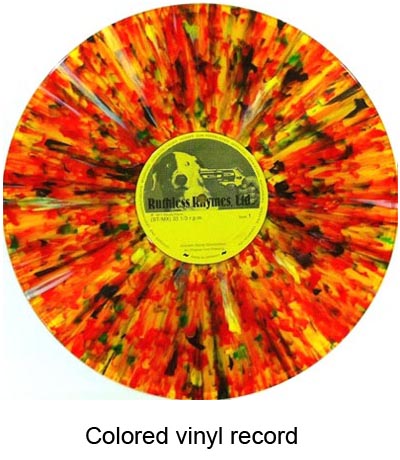 If you have spent any time around records, either 45 RPM singles or albums, you might have encountered the term “colored vinyl records.” You might think that’s a strange question; after all, all records are colored vinyl records, aren’t they? And aren’t they all black?
If you have spent any time around records, either 45 RPM singles or albums, you might have encountered the term “colored vinyl records.” You might think that’s a strange question; after all, all records are colored vinyl records, aren’t they? And aren’t they all black?
Historically, most records are black, probably because black vinyl is relatively inexpensive compared to other colors of vinyl and possibly because the dark colors might help obscure any impurities that might be in the compound.
This isn’t a new thing; since the introduction of the commercial cylinder record in 1889, most records of any kind have been made from materials that were either naturally black or which were colored during the manufacturing process to make them appear to be black. The reasons for this had to do with both cost and with quality control. When you use different types of materials and different sources, you can make sure that all of your finished product looks the same by adding substances to make them look black.
Despite this, over the years, a few recordings, dating to the cylinder era, have been manufactured as colored vinyl records, with “colored vinyl” generally defined as some color other than black. Colored vinyl records have long been popular with collectors and they usually command a premium price on the collector market. In this article, we’ll cover the history of colored vinyl records and show examples of some of the more interesting ones we’ve seen over the years.
Browse by Category
Click any of the links below to jump to each category:
Colored Vinyl Records History
Older Labels That Manufacture Colored Vinyl Records
Liberty Colored Vinyl Records
Bel Canto Colored Vinyl Records
Columbia Colored Vinyl Records
Promotional Colored Vinyl Records
Japanese Colored Vinyl Records
Taiwan Colored Vinyl Records
Mass Market Colored Vinyl Records
Unusual Colored Vinyl Records
Privately Pressed Colored Vinyl Records
Unauthorized or Pirate Colored Vinyl Records
Colored Vinyl Records Today
Featured Products
Click here to view our selection of colored vinyl records.
Colored Vinyl Records History
The earliest examples of colored vinyl records date to 1908, with the introduction of Blue Amberol cylinders by the Edison company. These cylinders, which were more durable and had longer playing time than the earlier versions, used celluloid that was dyed blue in order to make them stand out in the marketplace.
 In about 1920, the then-new Vocalion records pressed colored vinyl records in the form of a reddish-brown, mostly to distinguish their products from others in the marketplace. While the company claimed that their records were more durable than the black ones offered by their competitors, the red color was mostly a marketing ploy.
In about 1920, the then-new Vocalion records pressed colored vinyl records in the form of a reddish-brown, mostly to distinguish their products from others in the marketplace. While the company claimed that their records were more durable than the black ones offered by their competitors, the red color was mostly a marketing ploy.
Most records sold at the time were packaged in simple paper sleeves, rather than in custom covers, as albums are today. If a buyer were to browse through a stack of records and notice that some of them were colored vinyl records, they might be more likely to buy one, simply because it was a bit unusual.
In the 1930s, Columbia Records pressed a number of 78s as colored vinyl records, with most of them being blue.
Far more interesting were the records from Seattle-based Morrison Records, which began pressing colored vinyl records in the 1940s using multicolored vinyl.
 Because of the way the vinyl was mixed, no two records, including those pressed consecutively, were alike. Though the tiny label had no artists of note on their roster, their records are moderately collectible today simply because of their unusual appearance.
Because of the way the vinyl was mixed, no two records, including those pressed consecutively, were alike. Though the tiny label had no artists of note on their roster, their records are moderately collectible today simply because of their unusual appearance.
Record companies rarely pressed colored vinyl records in the early to mid-1940s, probably due to cost concerns and the rationing of materials mandated by World War II. In the late 1940s, when RCA introduced their then-proprietary seven inch 45 RPM records, the company made the decision to press colored vinyl records in eight different colors.
These colors represented different genres of music, with classical records being pressed on red vinyl, for instance, and country records being pressed using green vinyl. They did this only for singles, however; all of their albums were made using black vinyl.
This unique brand of marketing using colored vinyl records didn’t last long, probably due to cost concerns. By 1950 or so, RCA was pressing all of their records, including their singles, using black vinyl, though they did maintain the color distinction for their classical records, which had a red label and a blurb on the cover that said “RCA Red Seal.”
Older Labels That Manufactured Colored Vinyl Records
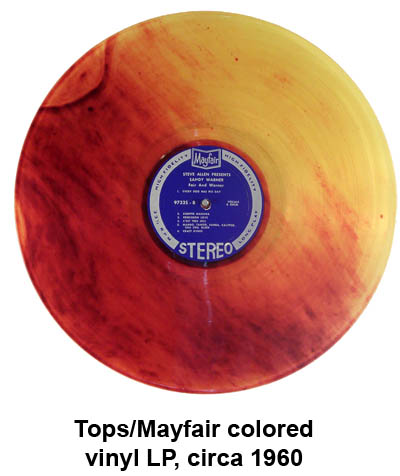 There were not a lot of colored vinyl records pressed in the 1950s, though a few small labels, such as Aladdin Records and Crown Records, pressed a few titles on red vinyl.
There were not a lot of colored vinyl records pressed in the 1950s, though a few small labels, such as Aladdin Records and Crown Records, pressed a few titles on red vinyl.
Crown’s decision to make colored vinyl records is a bit odd, since the company was a budget label that mostly issued recordings that had previously been released by other companies.
Though Crown used the more expensive red vinyl, as opposed to the common black, they cut corners in other ways by producing poorly-constructed covers that had no reinforcement at the seams and by selling their albums without paper inner sleeves.
Another budget label that pressed colored vinyl records was the Tops label from California. Tops released mono records; their stereo pressings were issued on the sister label, Mayfair. These labels issued a few titles on red and yellow vinyl, with yellow vinyl being the most common. Here’s an example of a multicolored vinyl record from Mayfair by actress and model Sandy Warner.
Liberty Colored Vinyl Records
Stereo records were introduced to the market in late 1957, but not all labels immediately began producing them, as the market for them initially was quite small. Most of the labels, including the larger ones, introduced stereo pressings slowly. Liberty Records, then a major label, added stereo pressings to their catalog in 1960.
To celebrate, Liberty pressed a handful of titles as colored vinyl records using both blue and red vinyl. Oddly enough, the fact that these titles were colored vinyl records wasn’t advertised in any way on the cover, but would simply come as a surprise to the buyer. While Liberty issued records on both blue and red vinyl, the red vinyl pressings seem to be more common than the blue ones.
Although most of the titles in this limited series were pressed using either one color or the other, at least three titles, Julie London’s Julie is Her Name, Martin Denny’s Exotic Sounds from the Silver Screen and Spike Jones’s Omnibust, were pressed on both colors of vinyl.
Bel Canto Colored Vinyl Records
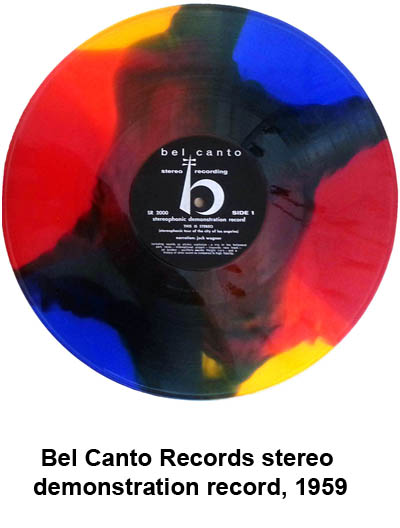 A short-lived record label from Columbus, Ohio, Bel Canto, arrived on the scene in the late 1950s. Bel Canto was an odd label in a number of ways. First of all, they were located in Ohio, away from the music scenes on either coast.
A short-lived record label from Columbus, Ohio, Bel Canto, arrived on the scene in the late 1950s. Bel Canto was an odd label in a number of ways. First of all, they were located in Ohio, away from the music scenes on either coast.
The company was owned by Thompson-Ramo-Woolridge (later TRW), a company known as an aerospace company and defense contractor, not as an entertainment company. Even more odd was the fact that Bel Canto released all of their albums on colored vinyl and in stereo only, which was quite unusual at a time when more than nine records out of ten were sold in mono.
One of Bel Canto’s titles, a stereo demonstration record, was pressed on multicolored vinyl. Most of Bel Canto’s releases fell into the light jazz and popular vocal category, and as far as we know, the label was out of business well before 1965.
Columbia Colored Vinyl Records
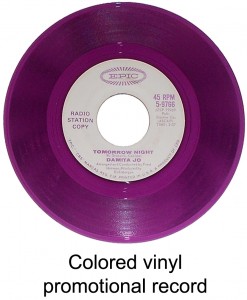 In the 1960s, a few record companies, notably Columbia Records and their affiliated label, Epic, began pressing colored vinyl records for promotional use.
In the 1960s, a few record companies, notably Columbia Records and their affiliated label, Epic, began pressing colored vinyl records for promotional use.
The record company realized that radio station program managers often received dozens of records per month, and they wanted their product to stand out among them and perhaps get airplay as a result.
Columbia pressed hundreds of colored vinyl singles throughout the 1960s by artists as diverse as Andy Williams, Eydie Gorme, Patti Page, The New Christy Minstrels, Bob Dylan, the Yardbirds, Simon and Garfunkel and the Dave Clark 5.
Colors of vinyl used were green, blue, red, yellow, purple and orange, though red was by far the color used most often.
Columbia also pressed at least 14 colored vinyl albums for promotional use on red, yellow, blue, purple and green vinyl. The selection of albums pressed as colored vinyl records wasn’t nearly as diverse as the label’s singles; the titles were all easy listening, classical or soundtrack/original cast recordings.
Perhaps the most noteworthy among them were two different titles by Barbra Streisand – The Second Barbra Streisand Album was pressed on blue vinyl and Color Me Barbra was pressed on red vinyl.
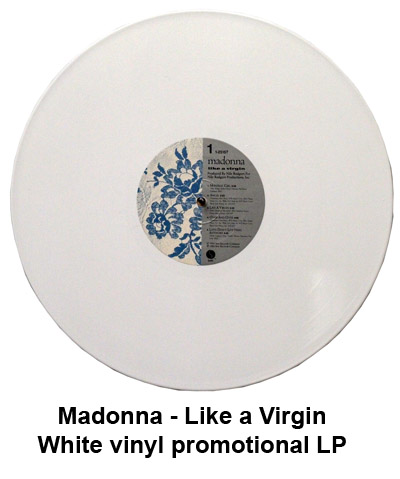 Occasionally, starting in the 1970s and continuing to the present day, other record labels have pressed some of their titles as colored vinyl records exclusively for promotional use.
Occasionally, starting in the 1970s and continuing to the present day, other record labels have pressed some of their titles as colored vinyl records exclusively for promotional use.
Sometimes these were intended as a tool to get the record played on the radio and at other times, they were simply pressed as a “thank you” to radio personnel for having promoted the record already.
As a rule these rare pressings always sell for higher prices than their black vinyl counterparts that were sold in stores.
A few examples:
- The Beatles – Reel Music – yellow vinyl; limited to 12,000 numbered copies
- Electric Light Orchestra -Ole ELO! – yellow vinyl
-
- Electric Light Orchestra -Out of the Blue – blue vinyl
- Fabulous Poodles – Mirror Stars – pink vinyl
- Elton John – Captain Fantastic and the Brown Dirt Cowboy – brown vinyl; autographed on the inside cover by Elton John and Bernie Taupin (2000 copies)
- Madonna –Like a Virgin – white vinyl
- Madonna -Bedtime Stories – pink vinyl
- Tom Petty and the Heartbreakers – You’re Gonna Get It – red vinyl
- Sparks – Introducing Sparks – red vinyl
The Chicago-based Chess label, which issued rhythm and blues records in the 1950s and 1960s, and its jazz subsidiary, Argo, pressed a number of titles on beautiful multicolored vinyl in the 1960s as promotional items.
Japanese Colored Vinyl Records
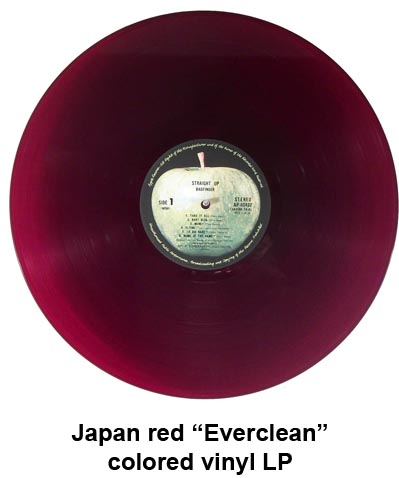 In 1958 in Japan, Toshiba Musical Industries, one of the two or three large manufacturers of records in Japan, began pressing colored vinyl records, with the introduction of their red, “Everclean” vinyl.
In 1958 in Japan, Toshiba Musical Industries, one of the two or three large manufacturers of records in Japan, began pressing colored vinyl records, with the introduction of their red, “Everclean” vinyl.
This vinyl compound was created in order to be more resistant to static electricity, and was intended to help prevent records from accumulating dust. Toshiba pressed red colored vinyl records from 1958 through early 1974, though they often coexisted on the shelves with black vinyl pressings.
Labels that were pressed by Toshiba included Capitol Records (and all of their subsidiaries), Odeon Records, Warner Brothers Records (through 1970), Liberty Records, Stateside Records, and World Pacific Records.
While the red Everclean vinyl was intended to prevent the buildup of static electricity, the label was inconsistent in its use, as only a small percentage of the albums and singles pressed during that sixteen year period were made using that vinyl compound.
Furthermore, there seemed to be no rhyme or reason as to which albums would be issued on red vinyl and which only on black, and sometimes that was the case even with a particular title. In some cases, promotional copies of a particular album might have been pressed with red (or black) vinyl while the copies available for sale in the stores might be either the same or perhaps the opposite color.
Though these Everclean pressings were not manufactured with the specific intention that they be collectors’ items, they have become so over time, and a red vinyl copy of a given album will always sell for a higher price than its black vinyl counterpart, even if the red vinyl version is more common than the black one. Red vinyl LPs exist for such artists as the Beatles, Creedence Clearwater Revival, Pink Floyd, The Grateful Dead, Grand Funk Railroad, and Julie London, among numerous others.
Japanese records are collectible for a number of other reasons that you can read about here.
Taiwan Colored Vinyl Records
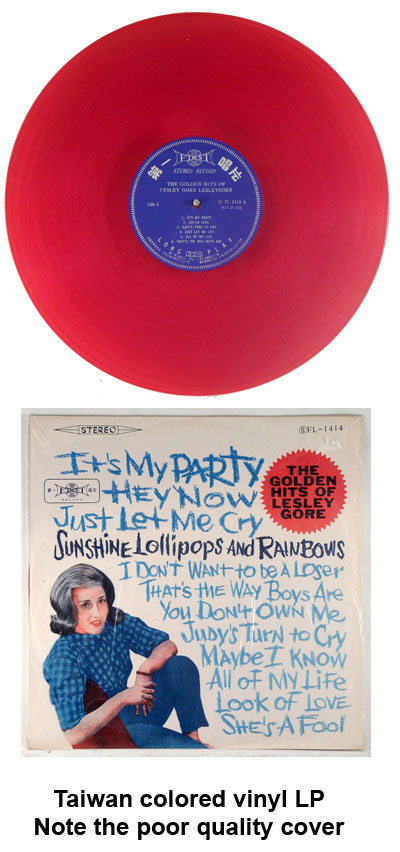 In the 1960s, thousands of titles were released in Taiwan as colored vinyl records. None of the record companies in Taiwan seem to have had legitimate licensing arrangements with major American or European record labels, however, making all of these titles unauthorized.
In the 1960s, thousands of titles were released in Taiwan as colored vinyl records. None of the record companies in Taiwan seem to have had legitimate licensing arrangements with major American or European record labels, however, making all of these titles unauthorized.
The most common colors used for these colored vinyl records were a pale green, a bright orange and a bright red. Some had English language label names, such as First Records, while others were printed in Chinese.
The albums were of poor quality, and while the records sounded terrible, being dubbed from other records, the quality of the album covers was even worse. The artwork was poorly printed on ultra-thin paper that was laminated in thin plastic.
What these colored vinyl records lacked in quality, they made up in quantity – nearly every major artist of the 1960s saw their albums issued as colored vinyl records in Taiwan. These include titles by Elvis Presley, the Beatles, the Rolling Stones, the Beach Boys, and hundreds of other artists.
Despite their poor quality, these records are sought out by collectors today. In some cases, these albums represent the only colored vinyl albums available by a particular artist.
Mass Market Colored Vinyl Records
Seeing an opportunity to make some money from record collectors by selling them the same titles a second time, record companies began pressing colored vinyl records as limited edition collectibles in the late 1970s. Albums by bands such as the Beatles, Pink Floyd, Led Zeppelin, Rush, Elton John, AC/DC, and the Eagles were pressed on various colors of vinyl for a short time.
While a few of these titles were domestically produced, such as the Beatles’ White Album, most of them were available in the United States only as imports from Canada, England and the Netherlands. Several of the titles from England, including the Beatles’ Abbey Road, Let It Be and Magical Mystery Tour, were pressed exclusively for export, making them quite hard to find in England today.
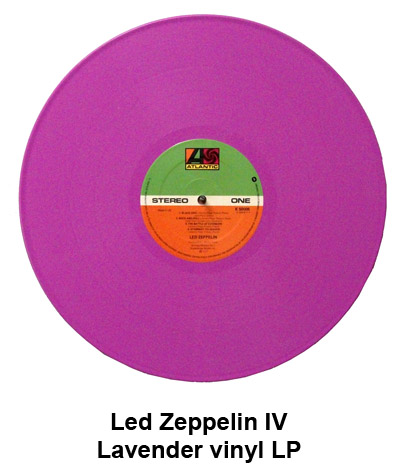 Here’s a list of a few of the titles pressed on colored vinyl in the late 1970s (not comprehensive):
Here’s a list of a few of the titles pressed on colored vinyl in the late 1970s (not comprehensive):
- AC/DC
- Got Blood If You Want It – multicolored vinyl (Netherlands)
- Powerage – red vinyl (Canada)
- Beatles (article about Beatles colored vinyl albums here)
- 1962-1966 – red vinyl (U.S., Japan, France, Germany, UK, and possibly others)
- 1967-1970 – blue vinyl (U.S., Japan, France, Germany, UK, and possibly others)
- Abbey Road – green vinyl (UK; export only)
- Greatest Hits – gold vinyl, purple vinyl (Netherlands)
- Magical Mystery Tour – yellow vinyl (UK; export only)
- Let It Be – white vinyl (UK; export only)
- Love Songs – yellow vinyl (Canada)
- Sgt. Pepper’s Lonely Hearts Club Band – gray marbled vinyl (Canada) clear, green, yellow, blue, purple, orange (France)
- White Album – white vinyl (U.S., France, Germany, UK (export only) and possibly others)
- Crosby, Stills, Nash and Young – Deja Vu – brown vinyl (UK)
- Eagles – Greatest Hits green vinyl (UK)
- Hotel California green vinyl (Netherlands)
- Fleetwood Mac
- Fleetwood Mac – white vinyl (UK)
- Rumours – white vinyl (Netherlands)
- Elton John
- Blue Moves – blue vinyl (France)
- Goodbye Yellow Brick Road – yellow vinyl (UK)
- Led Zeppelin – IV – lavender vinyl (UK)
- Alan Parsons Project – Tales of Mystery and Imagination – yellow vinyl (Canada)
- Pyramid – orange vinyl (Netherlands)
- Pink Floyd
- Animals – pink vinyl (France) two versions; one has an all-pink cover!
- Atom Heart Mother – blue vinyl (France)
- Dark Side of the Moon – white vinyl (Germany, Netherlands)
- The Wall – orange vinyl (Italy)
- Wish You Were Here – blue vinyl (Germany, Netherlands)
- Ramones – Road to Ruin – yellow vinyl (UK)
- Rush – Hemispheres – red vinyl (Canada)
- Rolling Stones
- Beggar’s Banquet – white vinyl (Netherlands)
- Between the Buttons – yellow vinyl (Netherlands)
- Big Hits, High Tide and the Green Grass – orange vinyl (Netherlands)
- Black and Blue – blue vinyl (Netherlands)
- Get Your Yeah Yeahs Out – blue vinyl (Netherlands)
- Let It Bleed – red vinyl (Netherlands)
- Miss You (12” single) pink vinyl (Netherlands)
- Some Girls – orange vinyl (Netherlands)
- Their Satanic Majesties’ Request – white and clear vinyl (Netherlands)
- Through the Past, Darkly – green vinyl (Netherlands)
- Steely Dan
- Can’t Buy a Thrill – yellow vinyl (Canada)
- The Royal Scam – yellow vinyl (Canada)
- Greatest Hits – yellow vinyl (Canada)
- Aja – yellow vinyl, red vinyl (Canada)
- Synergy (Larry Fast)
- Electronic Realizations for Rock Orchestra – clear vinyl (U.S.)
- Sequencer – clear vinyl (U.S.)
- Chords – clear vinyl (U.S.)
- Neil Young – Harvest – peach colored vinyl (UK)
Many of these albums are now quite rare and are sought out among collectors, particularly the colored vinyl titles by The Beatles and Pink Floyd.
Unusual Colored Vinyl Records
 The majority of colored vinyl records are pressed using a single color – red, green, blue, etc. Occasionally, there have been examples of records pressed using more than one color or a color that wouldn’t be considered a “normal” color.
The majority of colored vinyl records are pressed using a single color – red, green, blue, etc. Occasionally, there have been examples of records pressed using more than one color or a color that wouldn’t be considered a “normal” color.
Twelve inch singles by Kraftwerk and Metallica have been issued on pale green “glow in the dark” vinyl. Madonna’s Hard Candy was released on a red and white swirl “candy” vinyl. Several titles, starting with Faust’s self-titled 1971 LP (UK) were pressed in clear, transparent vinyl.
A Bob Marley title was pressed with three colors of vinyl – red, yellow, and green, to evoke the colors of the Jamaican flag.
Others are made using a hodgepodge of colors and are known as “splatter” or “swirl” vinyl, depending on the appearance of the finished product.
There have been quite a few examples of multicolored vinyl pressings in recent years, mostly from small, privately-owned record companies. Third Man Records, run by Jack White of White Stripes fame, has released a number of unusual colored vinyl records in the past few years.
Privately Pressed Colored Vinyl Records
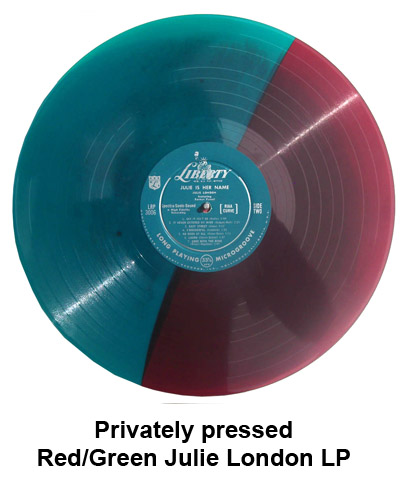 Sometimes, a record company or pressing plant employee will take it upon themselves to press colored vinyl records, even though they have not been authorized to do so by their employer. They may do this for their own use, or with the intention of secretly reselling the records at a profit at some point in the future.
Sometimes, a record company or pressing plant employee will take it upon themselves to press colored vinyl records, even though they have not been authorized to do so by their employer. They may do this for their own use, or with the intention of secretly reselling the records at a profit at some point in the future.
Because of the covert nature of these pressings, it’s not possible to document all of them, and sometimes, they aren’t even discovered until many years (or decades) after they were initially manufactured.
Collectors are generally very interested in these sorts of titles, provided that it can be demonstrated that they were manufactured at the time of the record’s initial commercial release and that they were made at the same facility used to press the regular, black vinyl copies of the same record.
Here’s a list of a few of the titles we’ve seen over the years that appear to have been privately pressed as colored vinyl records:
- The Beatles – A Hard Day’s Night – a single copy of this album is known to exist on pink vinyl. This copy was found at a Los Angeles yard sale!
- Dave Brubeck – Jackpot – one copy of this LP is known on blue vinyl
- Dion – Runaround Sue – copies of this 1962 LP are known to exist on both green and brown vinyl
- Fats Domino – Just Domino – One copy of this 1962 LP is known to exist on multicolored vinyl
- The Doors – The Doors – one test pressing of this album is known to exist on white vinyl
- Bob Dylan – John Wesley Harding – copies of this 1967 LP are known to exist on red and on yellow vinyl
- Electric Light Orchestra – Ole ELO! – While yellow vinyl copies of this album were officially issued as promotional items, there are also copies on red, white, and blue vinyl that were pressed by a record company employee.
- John Lennon/Yoko Ono – Milk and Honey – green and yellow copies exist; these were reportedly pressed from legitimate stampers, likely by a record company employee
- Julie London – Julie Is Her Name – a single copy of this 1955 LP is known to exist on half red/ half green vinyl (see photo)
- Ketty Lester – Love Letters – one copy is known to exist on multicolored vinyl
- Rolling Stones – Let It Bleed – two copies are known to exist on multicolored vinyl
- Nina Simone – The Amazing Nina Simone – one blue vinyl copy of this 1959 album is known
- Ike and Tina Turner – River Deep, Mountain High – one copy of this album is known on blue vinyl
This list is hardly comprehensive, but because of the nature of these pressings, it’s impossible to document all of them. New ones are discovered all the time; the Julie London album, pressed in 1955, turned up for the first time in 2014!
Unauthorized or Pirate Colored Vinyl Records
 Since collectors have demonstrated a willingness to buy just about anything by their favorite artist, a number of unscrupulous individuals have taken it upon themselves to issue quite a few colored vinyl records by famous artists.
Since collectors have demonstrated a willingness to buy just about anything by their favorite artist, a number of unscrupulous individuals have taken it upon themselves to issue quite a few colored vinyl records by famous artists.
These titles are technically known as “pirate” pressings; they very closely resemble official releases, but are actually unauthorized private pressings.
As these pressings are unofficial and are not related to official releases by the artist represented, nor are they authorized by the artists’ record companies, these pressings rarely attract much attention from record collectors.
They do, however, usually sell for quite a bit more than the standard, black vinyl pressings of the same title, usually selling for $30-$40.
Here are a few examples of titles we’ve seen for sale on colored vinyl that are unauthorized:
- Led Zeppelin
- Led Zeppelin I – multiple colors of vinyl
- Led Zeppelin II – multiple colors of vinyl
- Led Zeppelin III – multiple colors of vinyl
- Houses of the Holy – multiple colors of vinyl
- Physical Graffiti – multiple colors of vinyl
- Pink Floyd
- The Piper at the Gates of Dawn – multiple colors of vinyl
- A Saucerful of Secrets – multiple colors of vinyl
- Dark Side of the Moon – multiple colors of vinyl (these are distinctly different from the authorized pressings listed above)
There are numerous other examples of these, but it’s impossible to document all of them.
Colored Vinyl Records Today
Limited edition colored vinyl pressings continue to this day, particularly among companies that specialize in reissuing older titles. The original pressing of a Bob Dylan album from the 1960s might have been on black vinyl, but you can buy a red vinyl pressing today!
Many titles released in the past five years have been issued as colored vinyl records, sometimes for the entire run and sometimes as a limited edition item.
About five years ago, Warner Brothers Records began reissuing the entire Metallica catalog as high quality pressings, some were mastered at 45 RPM for better sound quality. All of these titles were briefly available as colored vinyl records, though several of the titles were limited to 100 colored vinyl copies. Later pressings in the series were manufactured in larger quantities to help satisfy collector demand.
Record companies today understand that it’s a bit more work than it used to be to persuade customers to pay cash for hard media, rather than downloads. Because of this, it’s quite common these days to see titles issued as colored vinyl records as an added incentive for the customer to buy.
That’s not the only reason why someone might want to buy colored vinyl records, however.
Because colored vinyl pressings are generally more free of impurities than black vinyl, many of them provide good sound quality. This is particularly true of those colored vinyl records which are pressed for promotional use by radio stations. Regardless of sound, they’re all popular among collectors, if for no other reason than the fact that they’re different and unique.
Click here to view our selection of colored vinyl records.
Share this:







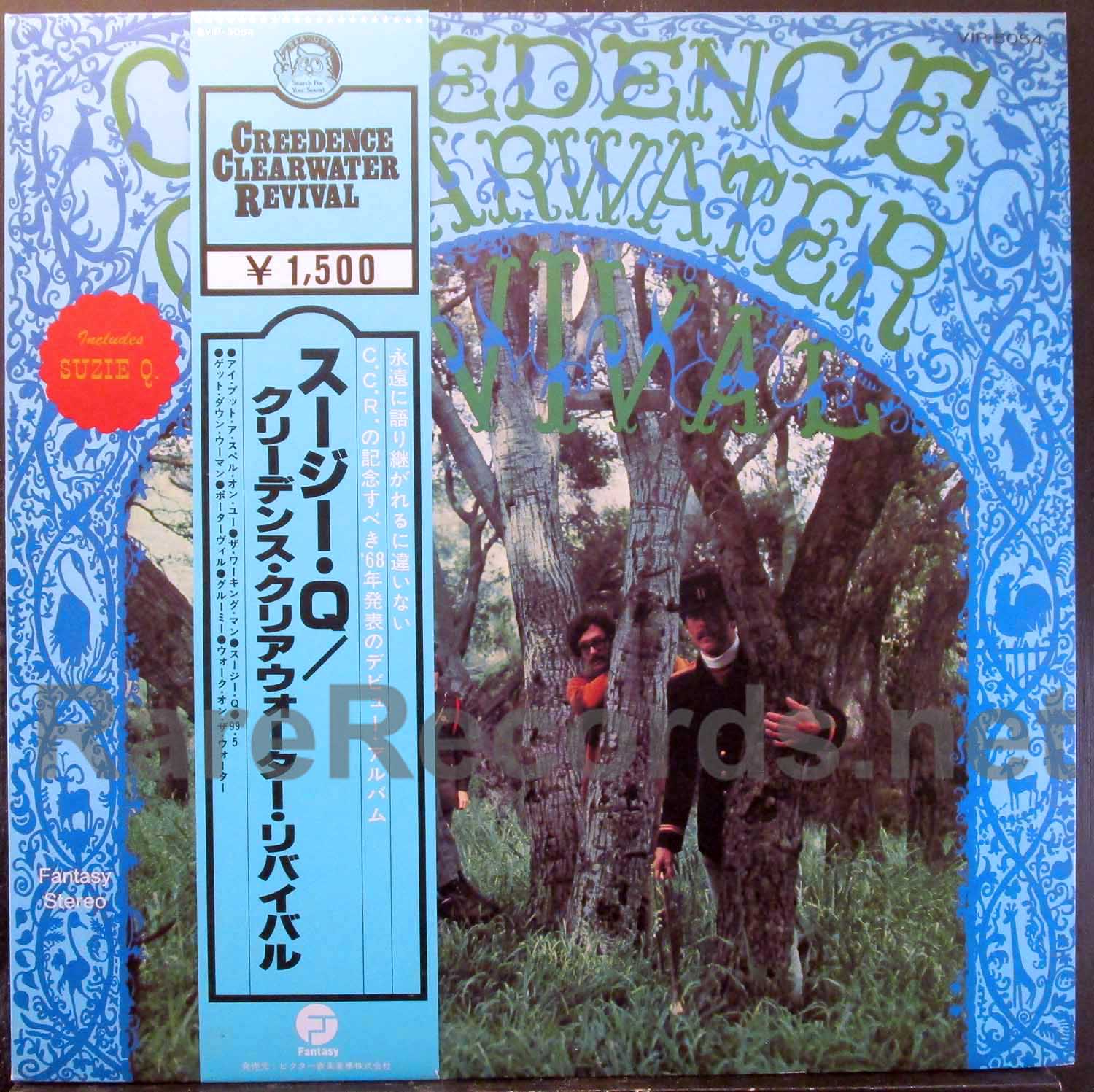
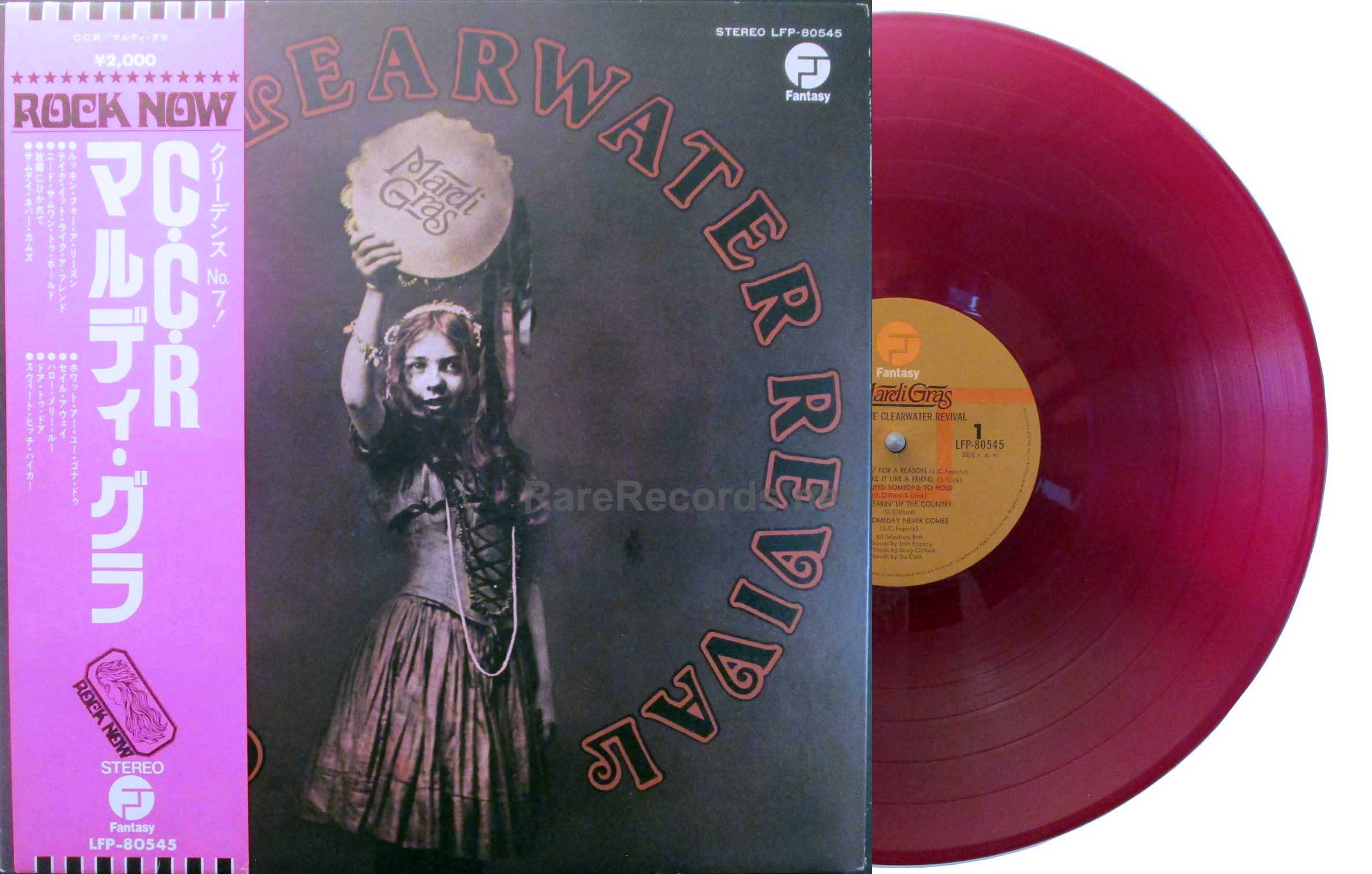
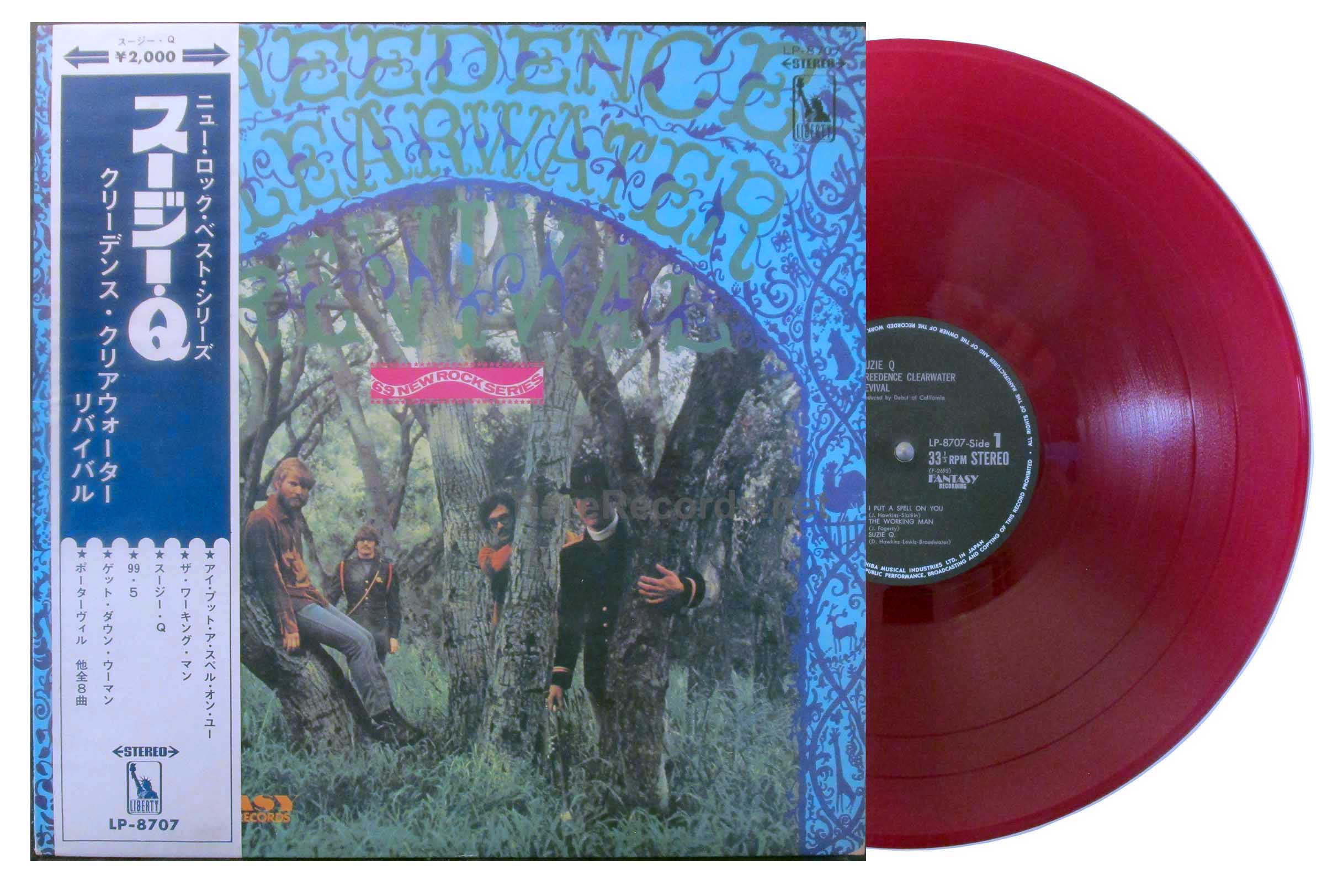
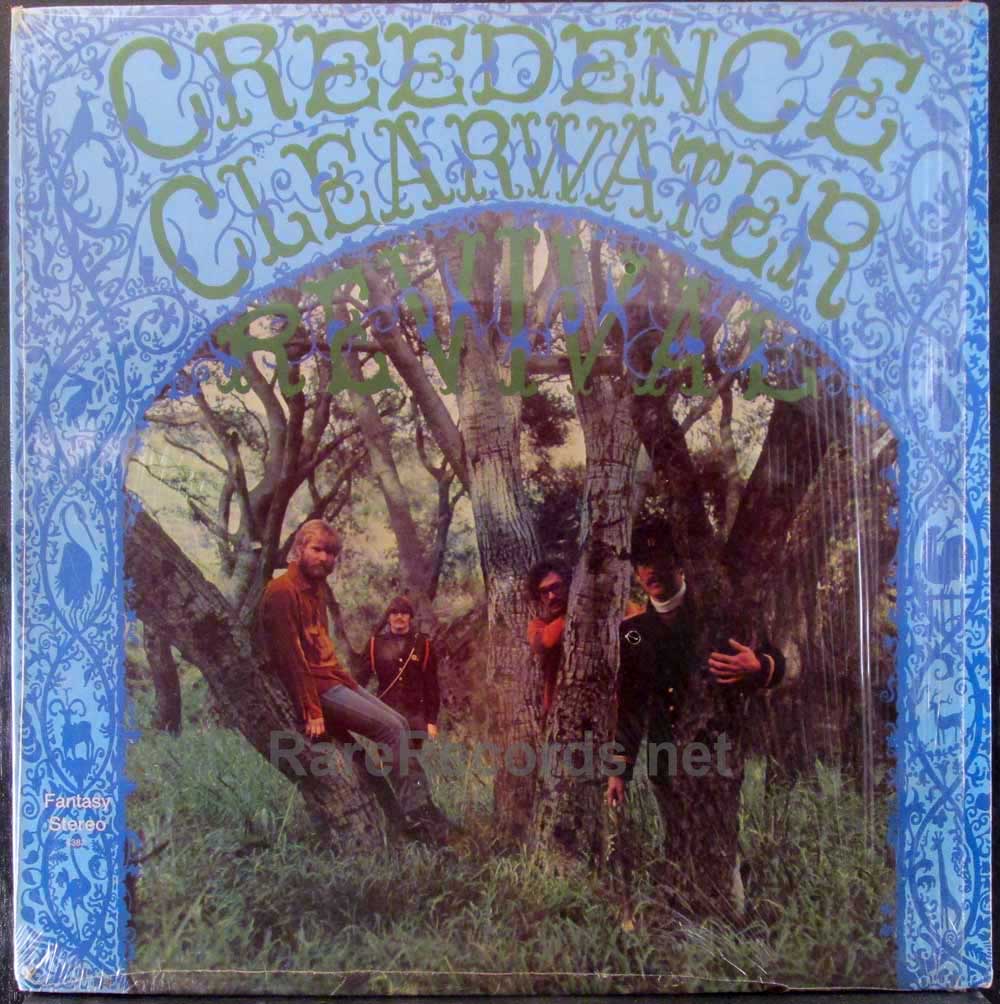
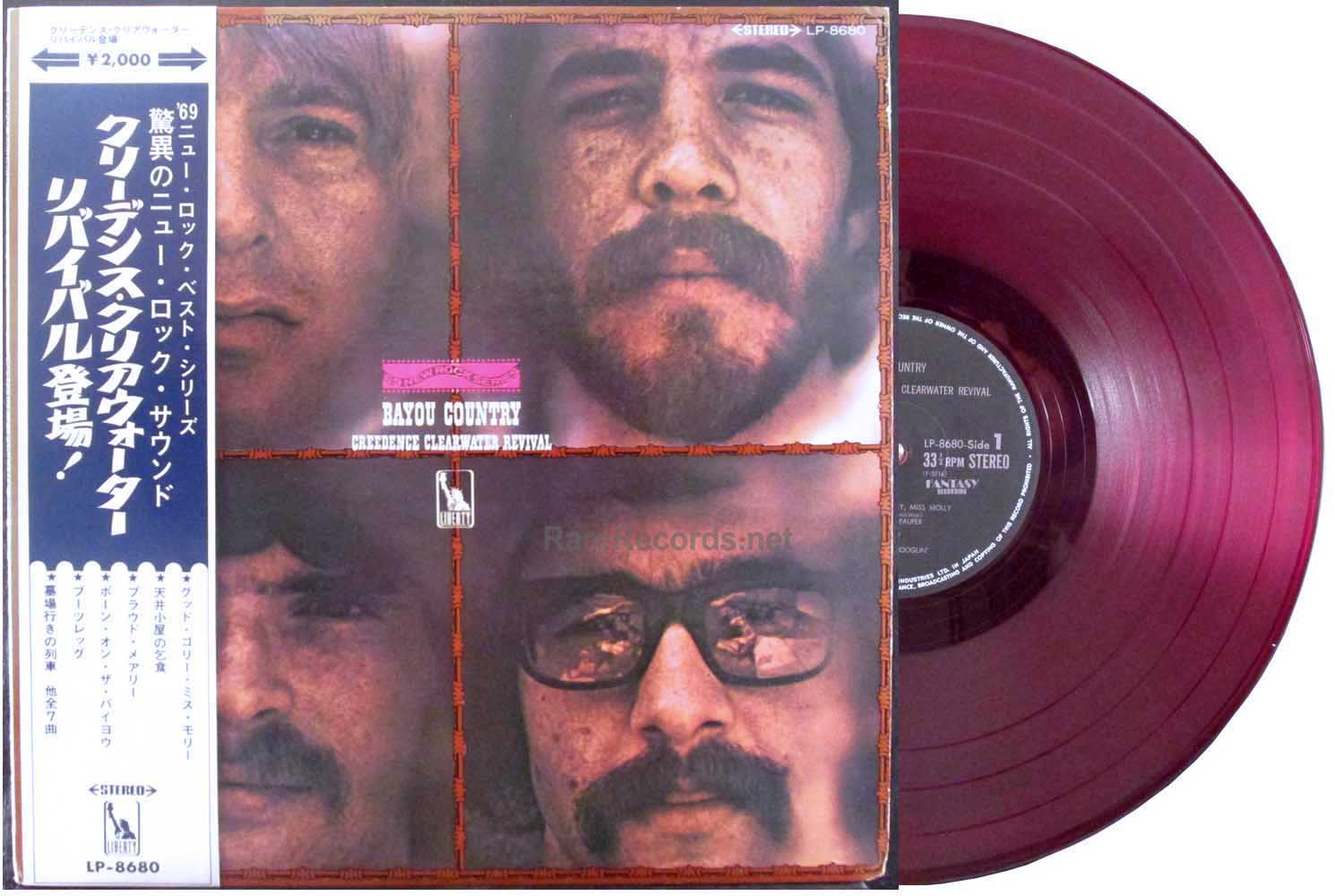
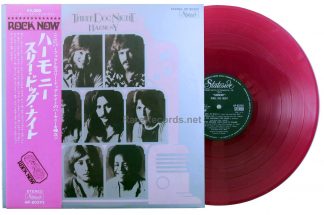
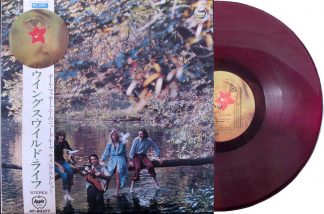
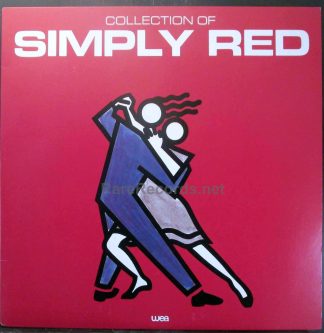
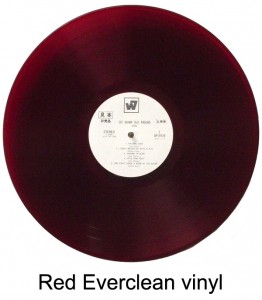
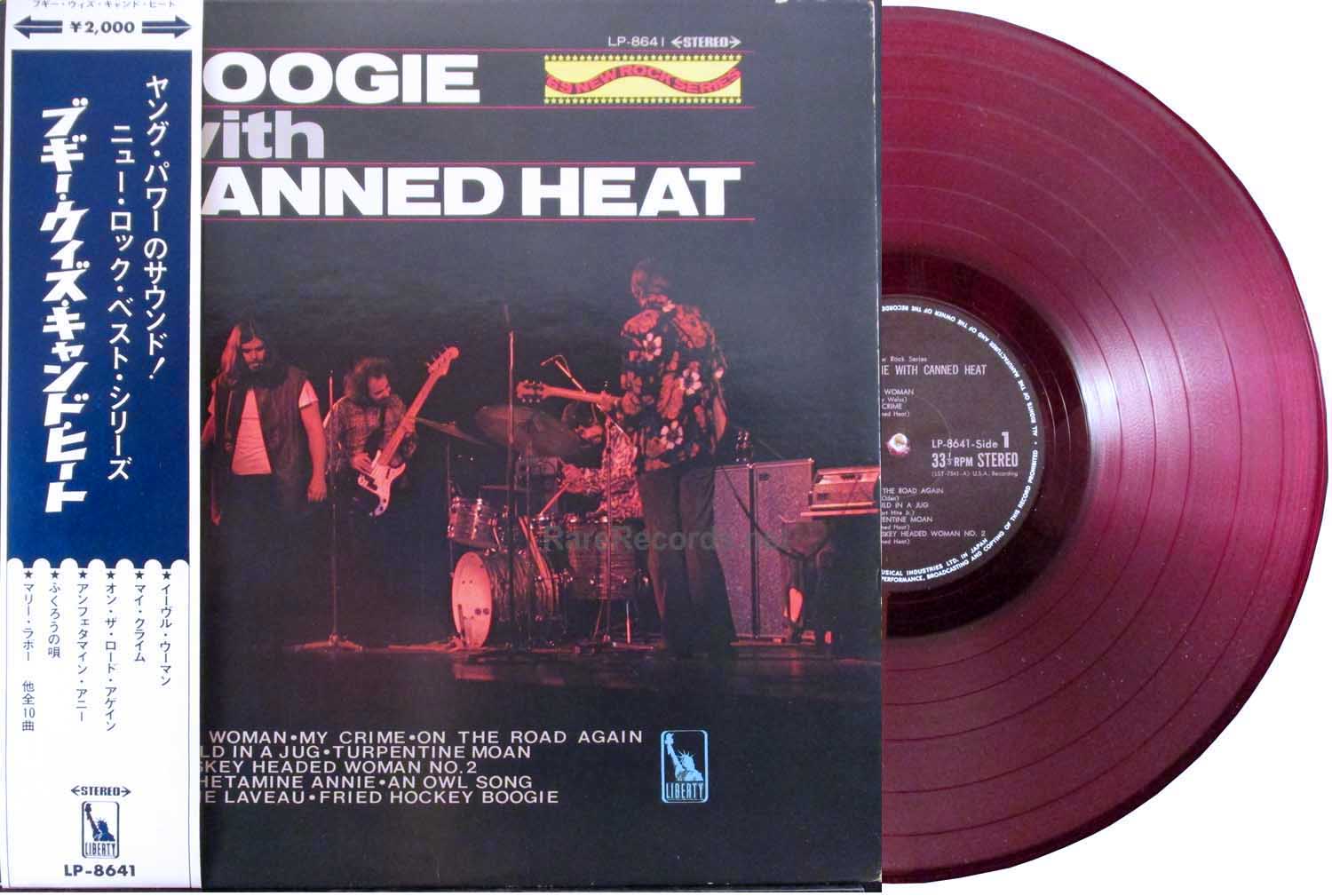 The decision regarding which Japanese records would be pressed on red vinyl was seemingly random; there was no way of knowing if a particular title by a given artist would be issued on black vinyl, red vinyl, or both.
The decision regarding which Japanese records would be pressed on red vinyl was seemingly random; there was no way of knowing if a particular title by a given artist would be issued on black vinyl, red vinyl, or both.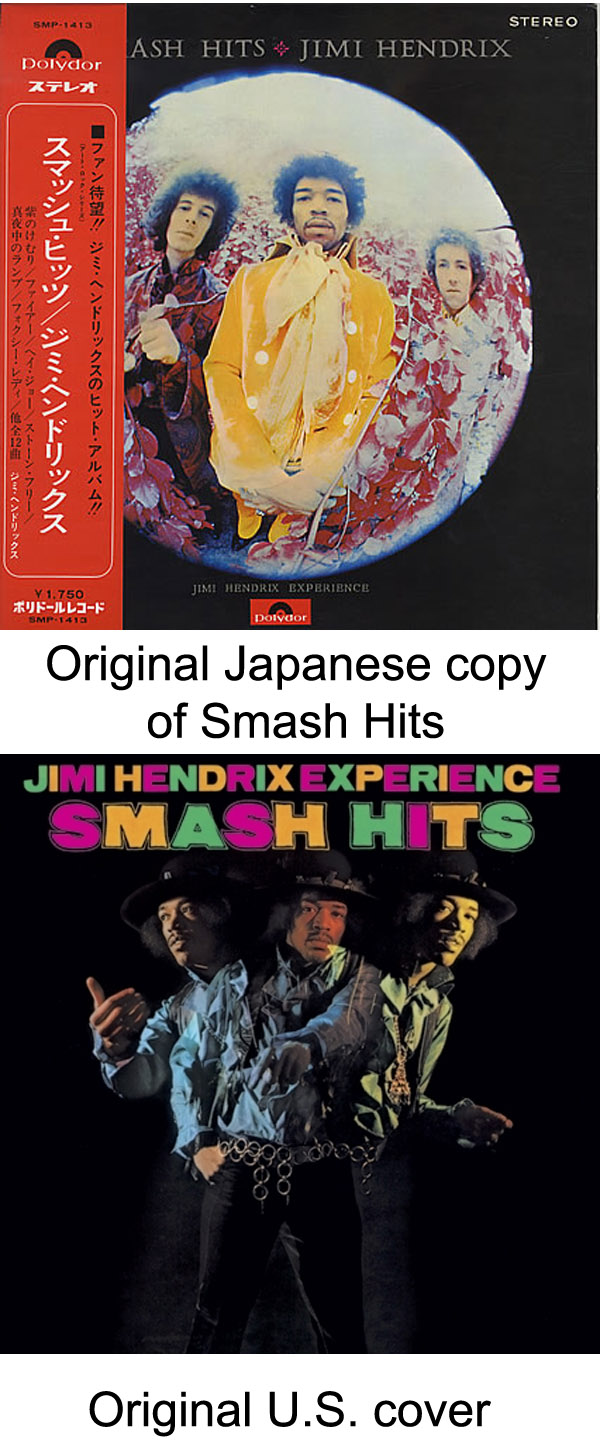 Different covers.
Different covers.
 If you have spent any time around records, either 45 RPM singles or albums, you might have encountered the term “colored vinyl records.” You might think that’s a strange question; after all, all records are colored vinyl records, aren’t they? And aren’t they all black?
If you have spent any time around records, either 45 RPM singles or albums, you might have encountered the term “colored vinyl records.” You might think that’s a strange question; after all, all records are colored vinyl records, aren’t they? And aren’t they all black?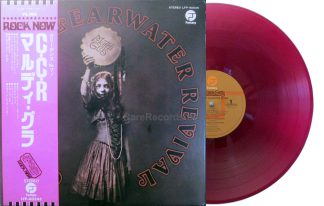
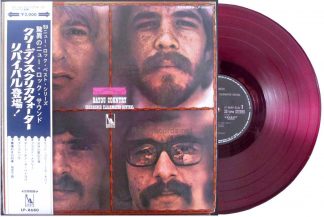
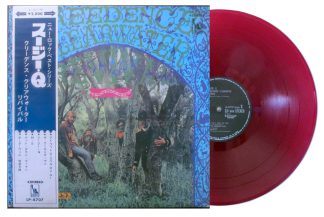
 In about 1920, the then-new Vocalion records pressed colored vinyl records in the form of a reddish-brown, mostly to distinguish their products from others in the marketplace. While the company claimed that their records were more durable than the black ones offered by their competitors, the red color was mostly a marketing ploy.
In about 1920, the then-new Vocalion records pressed colored vinyl records in the form of a reddish-brown, mostly to distinguish their products from others in the marketplace. While the company claimed that their records were more durable than the black ones offered by their competitors, the red color was mostly a marketing ploy. Because of the way the vinyl was mixed, no two records, including those pressed consecutively, were alike. Though the tiny label had no artists of note on their roster, their records are moderately collectible today simply because of their unusual appearance.
Because of the way the vinyl was mixed, no two records, including those pressed consecutively, were alike. Though the tiny label had no artists of note on their roster, their records are moderately collectible today simply because of their unusual appearance. There were not a lot of
There were not a lot of  A short-lived record label from Columbus, Ohio, Bel Canto, arrived on the scene in the late 1950s. Bel Canto was an odd label in a number of ways. First of all, they were located in Ohio, away from the music scenes on either coast.
A short-lived record label from Columbus, Ohio, Bel Canto, arrived on the scene in the late 1950s. Bel Canto was an odd label in a number of ways. First of all, they were located in Ohio, away from the music scenes on either coast. In the 1960s, a few record companies, notably Columbia Records and their affiliated label, Epic, began pressing colored vinyl records for promotional use.
In the 1960s, a few record companies, notably Columbia Records and their affiliated label, Epic, began pressing colored vinyl records for promotional use. Occasionally, starting in the 1970s and continuing to the present day, other record labels have pressed some of their titles as colored vinyl records exclusively for promotional use.
Occasionally, starting in the 1970s and continuing to the present day, other record labels have pressed some of their titles as colored vinyl records exclusively for promotional use. In 1958 in Japan, Toshiba Musical Industries, one of the two or three large manufacturers of records in Japan, began pressing colored vinyl records, with the introduction of their red, “Everclean” vinyl.
In 1958 in Japan, Toshiba Musical Industries, one of the two or three large manufacturers of records in Japan, began pressing colored vinyl records, with the introduction of their red, “Everclean” vinyl. In the 1960s, thousands of titles were released in Taiwan as colored vinyl records. None of the record companies in Taiwan seem to have had legitimate licensing arrangements with major American or European record labels, however, making all of these titles unauthorized.
In the 1960s, thousands of titles were released in Taiwan as colored vinyl records. None of the record companies in Taiwan seem to have had legitimate licensing arrangements with major American or European record labels, however, making all of these titles unauthorized. Here’s a list of a few of the titles pressed on colored vinyl in the late 1970s (not comprehensive):
Here’s a list of a few of the titles pressed on colored vinyl in the late 1970s (not comprehensive): The majority of colored vinyl records are pressed using a single color – red, green, blue, etc. Occasionally, there have been examples of records pressed using more than one color or a color that wouldn’t be considered a “normal” color.
The majority of colored vinyl records are pressed using a single color – red, green, blue, etc. Occasionally, there have been examples of records pressed using more than one color or a color that wouldn’t be considered a “normal” color. Sometimes, a record company or pressing plant employee will take it upon themselves to press colored vinyl records, even though they have not been authorized to do so by their employer. They may do this for their own use, or with the intention of secretly reselling the records at a profit at some point in the future.
Sometimes, a record company or pressing plant employee will take it upon themselves to press colored vinyl records, even though they have not been authorized to do so by their employer. They may do this for their own use, or with the intention of secretly reselling the records at a profit at some point in the future. Since collectors have demonstrated a willingness to buy just about anything by their favorite artist, a number of unscrupulous individuals have taken it upon themselves to issue quite a few colored vinyl records by famous artists.
Since collectors have demonstrated a willingness to buy just about anything by their favorite artist, a number of unscrupulous individuals have taken it upon themselves to issue quite a few colored vinyl records by famous artists.










